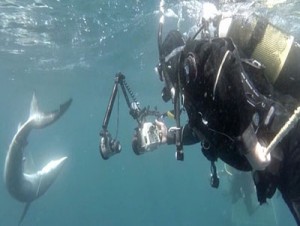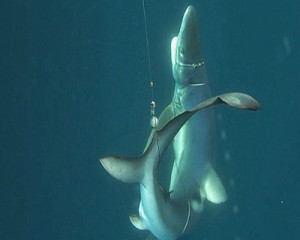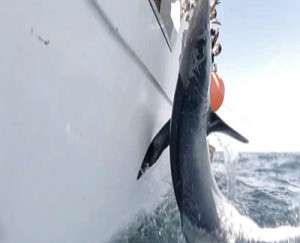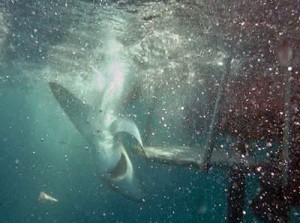Marine Life & Conservation
UK Blues – are sharks being stressed out in the name of science or to make a few quid from tourists?
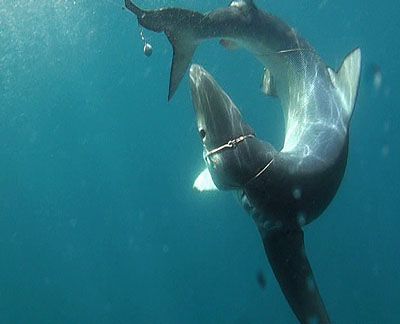
I was recently invited to a Blue Shark diving day in the UK. I am being a bit vague about where because my article really is a generic one and not aimed at anyone specifically.
The day started with laying out a trail of chum as we drifted. In this ‘scent trail’ the skipper set a line and baited hook for catching a shark with the intent of bringing it on board, showing the guests, taking measurements for research statistics and then letting it go.
Over the years as a TV wildlife filmmaker I have come across many such trips of which some are good and others really bad. Sometimes the quest for good research and care for the animals is diminished behind the need to make each trip pay financially by entertaining guests with a ‘shark experience’.
It was not long before the first shark was hooked and being played alongside the boat. A few of the guest divers were quickly in the water in the hope of seeing the shark swim past. Having tried to dive deep to safety, the shark, now nearing total exhaustion fights with the last of its energy, twisting and thrashing against the line holding it. For me this is a very sad sight and I know at least two of the divers left the water close to tears. At the same time, others thought this was great excitement.
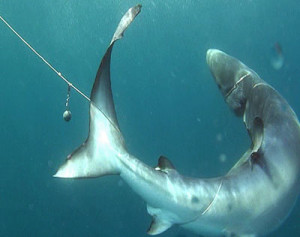 Getting wrapped in the line during this period can be harmful to the shark as well as increasing the time for lactic acid to build up in the muscle tissue which is one of the contributors to the inability of the shark to recover when released. Ideally the shark should be brought in as quickly as possible and so released the same.
Getting wrapped in the line during this period can be harmful to the shark as well as increasing the time for lactic acid to build up in the muscle tissue which is one of the contributors to the inability of the shark to recover when released. Ideally the shark should be brought in as quickly as possible and so released the same.
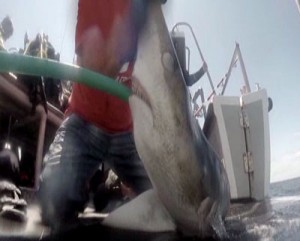 It was hauled by the hook and line over the side of the boat where a hose pipe was immediately pushed into its mouth to give a flow of water through its gills in order to help keep the shark alive while measurements were taken and people held the shark in their arms for a photo.
It was hauled by the hook and line over the side of the boat where a hose pipe was immediately pushed into its mouth to give a flow of water through its gills in order to help keep the shark alive while measurements were taken and people held the shark in their arms for a photo.
The internal skeleton of a shark is made of cartilage and connective tissue making the shark very flexible and light. The shark has no rib cage, so when it is on land its own weight can literally crush its internal organs. Hence the longer it is on the deck the more damage is done. Also when pulling a shark up and over the side of the boat, the internal organs are pulled by gravity to the lower end of the body. Generally it is far better not to bring any shark on board that is over a meter in length. Any science such as measuring and tagging should be done in the water when ever possible.
If it is necessary to bring a shark aboard then the technique recommended by many marine biologists is to use a sling at the side of the boat bringing the fish alongside and into it. Then lift it horizontally and gently onto the deck. I have done this myself and found it to be very workable and this method decreases the stress and strain on the shark. This sling can then be used to lower the shark back into the water.
At this stage there should be no reason to keep it out of the water for more that a few minutes. I have talked to shark biologists about the practice of putting the hose in its mouth and continually flushing the gills. The over-riding opinion is that this is not a good idea, or necessary, as it is likely to damage the gill tissues and so severely reduce the shark’s ability to recover. However, others are convinced that this hose pipe action does work and is necessary.
Finally the shark was released and lowered back into the water where it finned slowly while sinking out of sight into the depths. Did it live or die? We don’t know. The general consensus from the majority of marine biologists is that the rate of survival is good when care is taken to keep the shark free from over stress and physical damage.
We will forever debate the pros and cons of various opinions on how best to carry out our shark research, while at the same time, caring for the welfare of the individual animals. But in the end, it is the sharks who are paying the terrible price of pain and annihilation. To me we are simply recording statistics of the shark’s demise.
I sat on the boat after the shark was released and found myself gazing at all the incredible technology that lay in front of me. Diving equipment that allows us to explore the underwater world, computers that keep us safe from decompression, clever materials that keep us warm and dry. In the wheelhouse, the navigation equipment, the radar, the depth profilers, the coffee machine. Yet, with all this, we still find the need to put a hook into a shark’s mouth, drag it from the sea and possibly kill it all in the name of science and research. In many ways the human race has come a long way forward from the days of kill or be killed, but at the same time we seem to have kept one foot firmly in our primitive past.
So what do you think? Is it worth stressing out this magnificent creatures in this way to gain scientific research, or is the risk to their health just too high? Let us know in the comments section below.
Blogs
The Ocean Cleanup Breaks 10,000,000 KG Barrier

The Ocean Cleanup, the global non-profit project, has removed a verified all-time total of ten million kilograms (22 million lbs.) of trash from oceans and rivers around the world – approximately the same weight as the Eiffel Tower.
To complete its mission of ridding the oceans of plastic, The Ocean Cleanup uses a dual strategy: cleaning up the Great Pacific Garbage Patch (GPGP) to remove the plastic already afloat in the oceans, while stopping the flow of plastic from the world’s most polluting rivers.
Through cleaning operations in the GPGP and in rivers in eight countries, the cumulative total of trash removed has now surpassed ten million kilograms. This milestone demonstrates the acceleration of The Ocean Cleanup’s impact, while underlining the astonishing scale of the plastic pollution problem and the need for continued support and action.
While encouraging for the mission, this milestone is only a staging point: millions more tons of plastic still pollute our oceans and The Ocean Cleanup intends to continue learning, improving and innovating to solve this global catastrophe.
This announcement comes as governments from around the world meet to continue negotiations to develop a new legally binding instrument to end plastic pollution at INC4 in Ottawa, Canada. Representatives of The Ocean Cleanup will be in attendance and the organization will be urging decision-makers to collaborate towards a comprehensive and ambitious global treaty which addresses plastic at all stages of its life cycle and in all marine environments worldwide, including in areas beyond national jurisdiction.
It is encouraging to see that the need for remediation is reflected in the various options for potential treaty provisions. It is essential that the final treaty contains clear targets for the remediation of legacy plastic pollution, and reduction of riverine plastic emissions.
Tackling plastic pollution requires innovative and impactful solutions. The treaty should therefore incentivize the innovation ecosystem by fostering innovations that make maximal use of data, technology and scientific knowledge – such as those designed and deployed by The Ocean Cleanup.
‘After many tough years of trial and error, it’s amazing to see our work is starting to pay off – and I am proud of the team who has brought us to this point.’ said Boyan Slat, Founder and CEO of The Ocean Cleanup. ‘While we still have a long way to go, our recent successes fill us with renewed confidence that the oceans can be cleaned.’
The Ocean Cleanup was founded in 2013 and captured its first plastic in 2019, with the first confirmed catch in the GPGP coming soon after the deployment of Interceptor 001 in Jakarta, Indonesia. After surpassing one million kilograms of trash removed in early 2022, the non-profit project has since progressed to the third iteration of its GPGP cleaning solution, known as System 03, and a network of Interceptors currently covering rivers in eight countries, with more deployments set for 2024.
About The Ocean Cleanup
The Ocean Cleanup is an international non-profit organization that develops and scales technologies to rid the world’s oceans of plastic. They aim to achieve this goal through a dual strategy: stemming the inflow via rivers and cleaning up the legacy plastic that has already accumulated in the ocean. For the latter, The Ocean Cleanup develops large-scale systems to efficiently concentrate the plastic for periodic removal. This plastic is tracked and traced through DNV’s chain of custody model to certify claims of origin when recycling it into new products. To curb the tide via rivers, The Ocean Cleanup has developed Interceptor™ solutions to halt and extract riverine plastic before it reaches the ocean. Founded in 2013 by Boyan Slat, The Ocean Cleanup now employs a broadly multi-disciplined team of approximately 140. The foundation is headquartered in Rotterdam, the Netherlands.
For more information, visit: theoceancleanup.com and follow @theoceancleanup on social media.
Marine Life & Conservation
Steve Backshall to headline Shark Trust’s flagship event: For the Love of Sharks

Join a host of amazing, shark loving, speakers including Steve Backshall and the Shark Trust team for an evening celebrating shark conservation at the Royal Geographical Society in London this November.
Date: 29th November 2024
Time: 6-10pm
Location: Royal Geographical Society, London
Tickets: https://www.sharktrust.org/Event/flos24
The event will be a celebration of all things shark. Those lucky enough to get hold of tickets will hear from engaging guest speakers with a passion for sharks.
The line-up includes (*subject to change if unforeseen circumstances arise)
Steve Backshall: One of television’s busiest presenters, BAFTA award-winning wildlife expert Steve has been passionate about the wild world ever since he was young.
Steve’s impressive TV career has taken him all around the world, investigating a wide array of species and environments. Steve has filmed over 100 hours of children’s wildlife programmes with the BAFTA award winning Deadly 60 franchise and recently, with Sky Nature, for his new series ‘Whale with Steve Backshall’. He has been a patron for the Shark Trust for 10 years.
Simon Rogerson: is a photojournalist specialising in natural history, diving and the sea.
He is editor of SCUBA magazine, the official journal of the British Sub-Aqua Club. Simon started his career as a crime reporter but gravitated towards his ‘less depressing’ interest in underwater exploration, joining the staff of DIVE magazine in 1999. In 2005 he was named ‘Editor of the Year’ in the PPA’s Independent Publishing Awards. Simon also works as a freelance writer, contributing frequently to the Sunday Times and Telegraph, in addition to BBC Wildlife, Esquire, and a host of international diving magazines. He is the author of a book, Dive Red Sea, published by Ultimate Sports. Now based in Berkshire, Simon has been a Patron of the Shark Trust for 20 years.
More speakers to be announced soon. Head to the Shark Trust website to learn more.
The evening will also allow guests the final chance to see the Oceanic 31, shark art exhibition. Some of the artwork will be auctioned/raffled at the event, while the rest will be auctioned online to raise money for the Shark Trust Oceanic Programme.
For the Love of Sharks is an evening with something for everyone who is interested and fascinated by sharks. Join the Shark Trust, their Patrons, Trustees and Staff, along with a host of supporters for this celebration of shark conservation.
For more information or to buy a ticket: https://www.sharktrust.org/Event/flos24
-

 News3 months ago
News3 months agoCapturing Critters in Lembeh Underwater Photography Workshop 2024: Event Roundup
-

 Marine Life & Conservation Blogs3 months ago
Marine Life & Conservation Blogs3 months agoCreature Feature: Swell Sharks
-

 Blogs2 months ago
Blogs2 months agoMurex Resorts: Passport to Paradise!
-

 Blogs2 months ago
Blogs2 months agoDiver Discovering Whale Skeletons Beneath Ice Judged World’s Best Underwater Photograph
-

 Gear Reviews3 weeks ago
Gear Reviews3 weeks agoGEAR REVIEW – Revolutionising Diving Comfort: The Sharkskin T2 Chillproof Suit
-

 Gear Reviews3 months ago
Gear Reviews3 months agoGear Review: Oceanic+ Dive Housing for iPhone
-

 Marine Life & Conservation2 months ago
Marine Life & Conservation2 months agoSave the Manatee Club launches brand new webcams at Silver Springs State Park, Florida
-

 News2 months ago
News2 months agoPADI Teams Up with Wellness Brand Neuro to Drive Ocean Change and Create a Blue State of Mind


